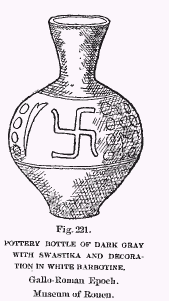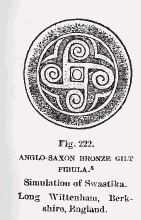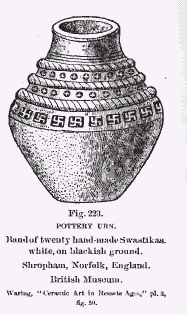

Dispersion of the Swastika
apparent. Fig. 221 represents
a pottery bottle with another specimen of Swastika belonging to the same
(Gallo-Roman) epoch, but coming from the extreme north of Gaul, the neighborhood
of Rouen. It is to be remarked that the ends of this  Swastika
give the outward curve or flourish similar to that noticed by Dr. Schliemann
on the spindle-whorl of Troy, and is yet employed in making the Jain Swastika
(fig. 33).
Swastika
give the outward curve or flourish similar to that noticed by Dr. Schliemann
on the spindle-whorl of Troy, and is yet employed in making the Jain Swastika
(fig. 33).
M. Alexander Bertrand (1)
speaks of the discovery at Valaux, in the department of Bouches-du-Rhóne,
of the headless statue of a crouching or squatting guard which has a row
of Swastikas across his breast, while beneath is a range of crosses, Greek
or Latin. The newest examples of the Swastika belonging to this epoch
have been found at Estinnes, Hainaut, and at Anthée, Namur, Belgium,
on pieces of Roman tile; also on a tombstone in the Roman or Belgo-Roman
cemetery of Juslensville near Peponster. (2)
This is a Pagan tomb, as evidenced by the inscriptions commenced "D.
M." (Diis Manibus). (3)
Anglo-Saxon Period.
Britain.
--- Greg reports (4) a silver
disk 1 1/2 inches in diameter, with a triskelion made by punched dots,
in the same style as the pin heads from Armenia (figs.
35 and 36). This was from
grave 95 in an Anglo-Saxon cemetery at Sleafors, England, excavated by
George W. Thomas and sold at Boston; bought by A. W. Franks and given
to the British Museum. Grave 143 had a large cruciform fibula of bronze,
partly gilt, similar to those from Scandinavia, with a Swastika on the
central ornament thus ![]() .
The slight curve or flourish on the outer end of the bent arm of this
specimen resembles the Jain Swastika (fig.
33), though this bends to the left, while the Jain Swastikas bend
to the right. Fig. 222 shows an Anglo-Saxon bronze gilt fibula with a
peculiar form of Swastika leaving a square with dot
.
The slight curve or flourish on the outer end of the bent arm of this
specimen resembles the Jain Swastika (fig.
33), though this bends to the left, while the Jain Swastikas bend
to the right. Fig. 222 shows an Anglo-Saxon bronze gilt fibula with a
peculiar form of Swastika leaving a square with dot  and
circle in its center. It was found in Long Wittenham, Berkshire, was reported
in Archæologia, (5) and
is figured by Waring. (6) A
figure having great similarity to this, even in its peculiarities and
called a Swastika, was found on a shell in Toco Mound, Tennessee (fig.
238). Fig. 223 represents an Anglo-Saxon urn from Shropham, Norfolk.
Its decorations consist of isolated figured like crosses, etc., arranged
in horizontal bands around the vessel, and separated by moldings. The
lower row consists of Swastikas of small size stamped into the clay and
arranged in isolated squares. There are twenty Swastikas in the band;
though they all turn to the right, they are not repetitions. They were
made by hand and not with the stamp. They are white on a blackish ground.
The original, which is in the British Museum, is cited by Kemble and figured
by Waring. (7)
and
circle in its center. It was found in Long Wittenham, Berkshire, was reported
in Archæologia, (5) and
is figured by Waring. (6) A
figure having great similarity to this, even in its peculiarities and
called a Swastika, was found on a shell in Toco Mound, Tennessee (fig.
238). Fig. 223 represents an Anglo-Saxon urn from Shropham, Norfolk.
Its decorations consist of isolated figured like crosses, etc., arranged
in horizontal bands around the vessel, and separated by moldings. The
lower row consists of Swastikas of small size stamped into the clay and
arranged in isolated squares. There are twenty Swastikas in the band;
though they all turn to the right, they are not repetitions. They were
made by hand and not with the stamp. They are white on a blackish ground.
The original, which is in the British Museum, is cited by Kemble and figured
by Waring. (7)
The Swastika on Ancient Coins.
There
has been much ink and imagination used, most of which has been wasted,
in the discussion of this branch of this subject. The opinion has been
 expressed
by many persons that the triskelion which formed the armorial emblem of
the island of Sicily, and also on the Isle of Man, is but an evolution
from or modification of the Swastika. In the judgment of the author this
is based rather upon the similarity of the designs than upon any likeness
in their origin and history. The acceptance by modern writers of this
theory as a fact is only justified from its long continued repetition.
expressed
by many persons that the triskelion which formed the armorial emblem of
the island of Sicily, and also on the Isle of Man, is but an evolution
from or modification of the Swastika. In the judgment of the author this
is based rather upon the similarity of the designs than upon any likeness
in their origin and history. The acceptance by modern writers of this
theory as a fact is only justified from its long continued repetition.
Triskelion, Lycia. --- The
triskelion on ancient coins first appears on the coins of Lycia, in Asia
Minor, about B. C. 480. It was adopted for Sicily by Agathocles, B. C.
317 and 307. The coins of Lycia were first three cocks' heads and necks
joined together equidistant in the center of the field, as shown in
fig. 224, while figs. 225
and 226 bear a center dot and circle. This forms a hub and axle. Out
of this hub spring three arms or rays, practically equidistant, the outer
ends being bent to the left. They increase in size as they progress
1. L'Autel de Saintes et les triades gauloises," Revue Archæol., 1880, XXXIX, p. 343. [Back]
2. Institut Archæologique Liégeois, X, 1870, p. 106, pl. 13. Back
3. "La Migration des Symboles,: p. 47, fig. 13. Back
4. Archæologia, I., pt. 2, p. 406, pl. 23, fig. 7. Back
5. Archæologia, XXXI. Back
6. "Ceramic Art in Remote Ages," pl. 43, fig. 10. Back
7. Ibid., pl. 3, fig. 50. Back
<< Previous Page Next Page >>
© 2004-2007 Northvegr.
Most of the material on this site is in the public domain. However, many people have worked very hard to bring these texts to you so if you do use the work, we would appreciate it if you could give credit to both the Northvegr site and to the individuals who worked to bring you these texts. A small number of texts are copyrighted and cannot be used without the author's permission. Any text that is copyrighted will have a clear notation of such on the main index page for that text. Inquiries can be sent to info@northvegr.org. Northvegr™ and the Northvegr symbol are trademarks and service marks of the Northvegr Foundation.

|